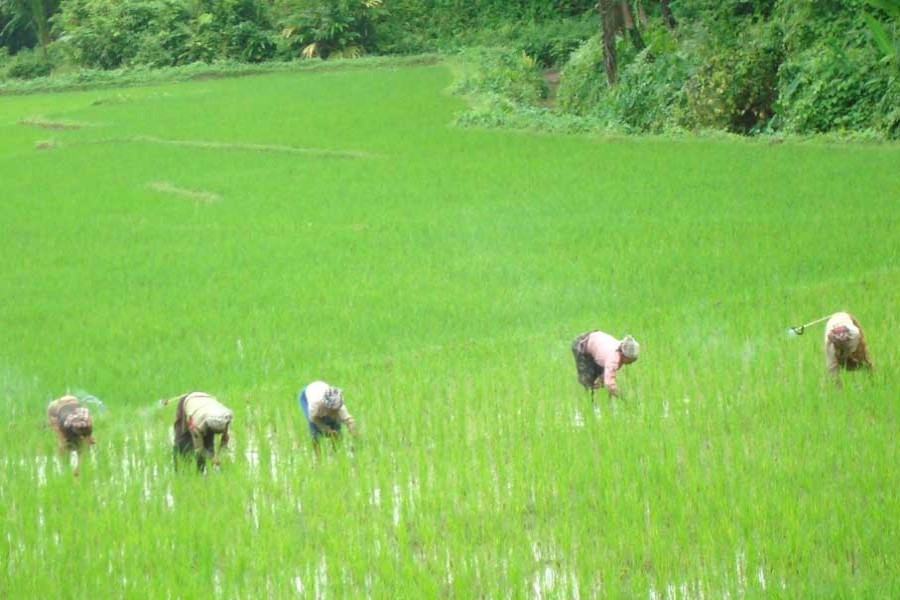
Published :
Updated :

Rural land market in Bangladesh is very narrow and getting narrower over time. For example, land transactions almost halved from 2.0 per cent in the 1980s to 1.0 per cent or so in recent years. This implies, and as argued by many, rural households hardly part with their land parcels unless they are driven by dire needs. Observations on land transactions then apparently contradict the conventional wisdom that small farmers would face marginalisation by selling land to large farmers. To explain this, we can draw upon some additional information. The proportion of land accumulated through purchases and sales is reported to be (-) 5.5 per cent for the marginal land owners, zero for the small owners, and 1.7 per cent for the medium and the large landowners. In a survey on land market in Punjab (India), it could be observed that land prices rapidly soared during the green revolution period but, surprisingly, annual sales of land drastically dropped. Apparently thus, it is not only in Bangladesh but also in India that land market is not as vibrant as it is generally presumed to be. Even then the situation here is a bit different from what had happened in India. Possibly, we can adduce two reasons to the apparent thinness of the land market.
First, those who usually make distress sales had overcome the periodic distress by adopting new technologies. Or else, to deal with the distress by increased income, many of them have moved to non-agricultural activities. Such a situation should shift the supply curve of land to the left and, thus, bring down the supply further. Second, since the price of land remains relatively high, it becomes easy to confront calamities by selling smaller amount of land at the same price. At this stage, we can invoke the insights on the incidence of land transactions during distress as presented by Dr S R Osmani. The researcher has shown that, during distress periods, the slope of the supply curve of land could be negative. However, despite the small transactions of land in rural Bangladesh, higher incidence of purchase than sales reminds us that rural-urban migration plays an important part in land transactions.
Besides direct purchases and sales, land transactions or exchanges also pass through two other channels -- credit market and tenancy market. Transactions through credit market are in evidence mostly with credit-constrained farmers who are deprived of access to the formal channel of credit. In this case, desperation drives them to knock at the doors of the 'lender of last resort' in the village -- 'mohajons' (money lenders) and large farmers. They engage in the struggle for livelihood by placing their land as collateral in exchange for loans at an exorbitant interest rate. It should be noted that such land mortgaging practices also prevail in formal markets, but there is a difference between the two. For example, the informal lender cultivates the land till the borrower repays the whole money. And, in case of failure to repay the loan after specified period, the lender reserves the right to purchase the parcel. It is being alleged that such kind of transaction takes place often at a price below the market price. This is called Dai-shudi system and assumes as one of the main land transfer systems in Bangladesh.
For ages, share-cropping had been the predominant tenancy system in Bangladesh. In economics discourse, the system is generally criticised for its inherent exploitative and anti-incentive syndromes. It is because the owner of the land shares half of the output without paying a penny for the inputs that the tenant uses. However, with the spread of modern high-yield paddy and wheat cultivation, some changes in contractual arrangements could be noticed in different parts of Bangladesh. For example, in some areas, not only harvests but also certain input costs are now shared by the landowners. On the other hand, arrangements like fixed-rent tenancy, advance cash-rental payments etc have increasingly stepped into the tenancy market as substitutes of the traditional share-cropping system.
But before we speak about the impact of rural tenancy market, it would be pertinent to scan through the established theoretical perspectives on such markets. The debate dates back few hundred years. Adam Smith argued that the system of share-cropping is inherently 'exploitative', and injects no incentive to the tenants for investment in modern inputs. Smith took for granted that both land owner and tenant would find no incentive to invest on land. On the other hand, Alfred Marshall held a stronger view against share-cropping system. He argued that, in addition to the negative impact on long-term investment from both the parties, the tenant would also lose the incentive to cultivate land intensively and efficiently. It is simply because his sweat under the sun would reap home only one-half of the additional output. So, why work hard? That means, labour-inputs under share-cropping would be less than other tenancy arrangements to impinge negative impact on the total output. In such a "loss-loss" situation, incomes of both the landowner and the tenant might go down.
Economist S Cheung came up with a solution. He argued that, if proper mechanisms could be developed to ensure that the tenant supplies optimal amount of labour, share-cropping could be as efficient as other arrangements. In fact, he suggested three such mechanisms where sharing of the input costs is one. But other economists opined that, with the development of agriculture, share-cropping is expected to surrender wider space to the fixed-rent system and, in course of time and under a system of information symmetry, share-cropping might even cease to exist. How far the trend is true in the case of Bangladesh will be taken up later.
Abdul Bayes is a former Professor of Economics at Jahangirnagar University.


 For all latest news, follow The Financial Express Google News channel.
For all latest news, follow The Financial Express Google News channel.